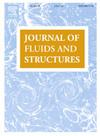基于缩放边界有限元法的新型半解析方法,用于三维容器中液体荡流的流固耦合分析
IF 3.4
2区 工程技术
Q1 ENGINEERING, MECHANICAL
引用次数: 0
摘要
本文基于缩放边界有限元法(SBFEM),提出了一种新颖的半解析方法,用于对水平方向上承受谐波和地震荷载的弹性容器中的液体荡流进行三维流固耦合分析。我们开发了一种改进的 SBFEM 模型,称为基于缩放面的 SBFEM,用于模拟被视为薄壳结构的容器壁。在基于缩放面的 SBFEM 框架内,壳体结构的几何形状完全由结构的一个缩放面决定。这种方法与标准 SBFEM 有很大不同,标准 SBFEM 是通过基于缩放中心的坐标映射来实现近似的,从而提高了建模精度和效率。在流体域的控制方程中,水动力压力被视为一个独立的节点变量,而流体域则使用基于缩放中心的标准 SBFEM 建模。耦合的流体-结构系统通过应用平衡和兼容性边界条件进行组装,以确保相互作用力的平衡。同步求解算法与纽马克方法的隐含-隐含方案相结合,用于确定耦合系统的动态响应。这种新方法的主要优点是对边界进行网格划分和离散化,而不是对整个结构域和流体域进行网格划分和离散化,从而降低了计算成本。此外,还可以沿内部域的径向获得分析解,从而提高结果的准确性和收敛性。该方法的另一个优点是能够为任何形状的结构提供统一的建模框架。此外,通过使用同步求解算法,可以有效避免系数矩阵的不对称问题。基准测试证实了所提出方法的卓越计算精度和鲁棒性。我们还进行了全面的参数研究,重点关注液体填充量以及几何和材料参数对流固耦合系统瞬态振动和分布行为的影响。本文章由计算机程序翻译,如有差异,请以英文原文为准。
A novel semi-analytical approach based on scaled boundary finite element method for fluid-structure coupling analysis of liquid sloshing in 3D containers
In this paper, a novel semi-analytical approach is proposed for the three-dimensional fluid-structure coupling analysis of liquid sloshing in elastic containers subjected to harmonic and seismic loading in the horizontal direction, based on the scaled boundary finite element method (SBFEM). A modified SBFEM model, referred to as the scaling surface-based SBFEM, is developed to simulate the container wall, which is treated as a thin shell structure. Within the framework of the scaling surface-based SBFEM, the geometry of the shell structure is entirely determined by scaling one surface of the structure. This approach differs significantly from the standard SBFEM, where approximation is achieved through coordinate mapping based on a scaling center, thereby enhancing the modeling accuracy and efficiency. Hydrodynamic pressure is treated as an independent nodal variables in the governing equations of the fluid domain, which is modeled using the standard scaling centre-based SBFEM. The coupled fluid-structure system is assembled by applying equilibrium and compatibility boundary conditions to ensure the balance of interaction forces. A synchronous solution algorithm, combined with the implicit-implicit scheme of the Newmark method, is used to determine the dynamic responses of the coupled system. The main advantage of this novel approach is that it meshes and discretizes the boundaries instead of the entire structural and fluid domains, thereby reducing computational costs. Additionally, analytical solutions can be obtained along the radial direction of the interior domain, enhancing the accuracy and convergence of the results. Another advantage is the approach's ability to provide a unified modeling framework for structures of any shape. Furthermore, the asymmetry issue of the coefficient matrix can be effectively avoided by using a synchronous solution algorithm. Benchmark examinations confirm the superior computational accuracy and robustness of the proposed approach. A comprehensive parametric study is conducted, focusing on the effects of liquid filling levels, as well as geometric and material parameters, on the transient vibration and distribution behaviors of the fluid-structure coupling system.
求助全文
通过发布文献求助,成功后即可免费获取论文全文。
去求助
来源期刊

Journal of Fluids and Structures
工程技术-工程:机械
CiteScore
6.90
自引率
8.30%
发文量
173
审稿时长
65 days
期刊介绍:
The Journal of Fluids and Structures serves as a focal point and a forum for the exchange of ideas, for the many kinds of specialists and practitioners concerned with fluid–structure interactions and the dynamics of systems related thereto, in any field. One of its aims is to foster the cross–fertilization of ideas, methods and techniques in the various disciplines involved.
The journal publishes papers that present original and significant contributions on all aspects of the mechanical interactions between fluids and solids, regardless of scale.
 求助内容:
求助内容: 应助结果提醒方式:
应助结果提醒方式:


